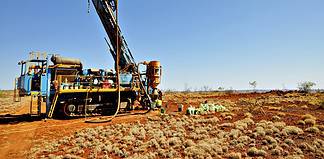THE term “gold leaf” now has a whole new meaning. CSIRO research has shown that gold does grow on trees. Or perhaps it would be more correct to say that trees grow in gold.
That’s the concept behind a mineral discovery technique CSIRO pioneered which is now being used successfully by gold exploration and mining companies.
Marmota Limited, a gold mining company working out of South Australia, recently reported IT had identified new gold targets using biogeochemical sampling at its Aurora Tank prospect.
Put simply, biogeochemical sampling involves taking samples of vegetation, such as leaves from trees and shrubs, and testing the material for the presence of gold or other chemicals that often associate with gold, so-called pathfinder elements.
Using this form of sampling, Marmota Limited found traces of gold in tree leaves, and used this information to guide their drill program.
Gold in gums
CIRO original work in Kalgoorlie in WA demonstrated how gum trees, growing above known areas of gold mineralisation, had detectable gold particles in their leaves and branches.
The trees’ deep root systems act like hydraulic pumps to bring tiny traces of metals from orebodies deep underground.
The metals particles taken up by the roots travel into the plant tissues of the shoots and leaves.
Even leaves that are shed still hold trace amounts of the metal.
Collecting and analysing the leaf material can reveal which areas of land contain deeper regions of gold mineralisation. The video below shows how this process works.
Golden greenery
From the initial trials in Kalgoorlie, researchers completed Australia’s biggest biogeochemical survey, creating a modern-day treasure map, sampling hundreds of eucalypts and mulga trees in the Northern Yilgarn Craton in WA.
The Craton makes up most of the WA land mass and is one of the oldest ancient landscapes preserved on earth.
The Eastern Yilgarn is renowned for gold and nickel deposits yet the Northern area remains largely unexplored for new mineral discoveries.
CSIRO mapped 130,000 sqkm of Australian bushland in the Northern Yilgarn – an area the size of Greece – looking for information about possible deposits of gold and a range of other economically valuable mineral commodities.
It found positive results for specific metals and pathfinder elements which can now be used to pinpoint areas to explore.
Biogeochemical sampling
Along with recently reported successes by industry, researchers further validated the method using convergent data from groundwater surveys.
The biogeochemical survey in the Northern Yilgarn overlapped an area previously surveyed using groundwater sampling and showed matching results.
Areas where gold was detected in groundwater samples coincided with areas where gold was detected in the vegetation samples.
Greenfield exploration (i.e. in areas with minimal or no previous exploration) is expensive and risky.
Geochemical sampling techniques are helping mineral exploration companies hone in on new targets for the next big discoveries.
By Keirissa Lawson, CSIRO.








































